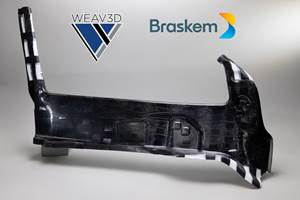Composites: Past, Present Future: Composites evolution the greatest change is yet to come
Composites aren't as new as we think, but they are ever in the process of renewal. Their past predates recorded history when ancient man fulfilled the modern definition of a composite by assembling readily available, easily formed materials: huts made from mud bricks reinforced with straw and boats from bundles of
Composites aren't as new as we think, but they are ever in the process of renewal.
Their past predates recorded history when ancient man fulfilled the modern definition of a composite by assembling readily available, easily formed materials: huts made from mud bricks reinforced with straw and boats from bundles of reeds that reinforced a bitumen matrix. In the 19th and 20th Centuries, similar thinking resulted in widespread use of products such as plywood and reinforced concrete. It was the use of polymers, however, that opened the door to what we now know as the composites industry.
Early experiments involved reinforcing thermoplastic and thermoset matrices with fibers, including organic fibers, such as cotton and bamboo, as well as spun glass. Metal shortages during World War II spurred additional research, culminating in a fiber-reinforced plastic (FRP) boom during the 1950s and 1960s. Lightweight materials and relatively low-capital molding processes contributed to the rapid commercialization of glass fiber-reinforced polymers in boat hulls, automobile bodies and aircraft components.
Until about 25 years ago, however, new composites were created largely by trial and error. These efforts were limited by the relatively small catalog of known polymer matrices and non-engineered fibers. In the past two-and-a-half decades, however, unprecedented thermoplastic development and the use of laboratory testing and analysis have rewritten the story. Extensive polymer properties databases for thermoplastics and thermosets now enable engineers to predict the behavior of combinations of matrices and fibers under projected conditions and exploit properties unique to composites, such as anistropic behavior and shape memory. Research sponsored by the U.S. Department of Energy (DoE) and the Department of Defense (DoD) greatly assisted in the collection and publication of these data. Meanwhile, NASA underwrote U.S. space program research that helped add high-modulus fibers to the knowledge base.
As a result, exceedingly robust matrix and fiber combinations were developed. However, because the emphasis was on optimizing properties for relatively low-volume applications, the high cost of materials — especially carbon fiber — and molding processes still hinder efforts to adapt them for high-volume commercial applications.
Although the thermoplastic databases today are actually more extensive, thermosets are still the plastic of choice for composite matrices, and the composite property database in either matrix type lags far behind the virgin resin database. That will change. Recycling of matrix and reinforcement eventually will be mandatory, a scenario that favors thermoplastics. Development of processes that separate matrix and fiber into reusable forms will be essential. The amount of energy used to manufacture composites and the emissions resulting from their disposal will become issues, especially as composites capture greater market share. This will open the door to greater use of natural fibers and nanoclays, as well as resins incorporating post-consumer and industrial waste materials. At the same time, efforts to develop low-cost, high-tensile fibers — ongoing DoE research into $3/lb carbon fiber, for example — will accelerate and techniques like three-dimensional weaving will reduce manufacturing costs by eliminating the labor involved in assembling layups.
While today's composites owe much to polymers, it has become clear that nanotechnology could shape the industry's long-term future. Nanoscale constructions are already showing promise, particularly in electrical conductivity, tensile strength, isotropic or anisotropic properties and shock and vibration resistance. Additionally, "smart" materials are being developed that can sense their environment and adjust their properties accordingly. But nano research, which offers the opportunity to reconstruct materials an atom and an electron at a time, promises much more. At the nanoscale, the distinctions between medical, biology, physics, chemistry and material sciences disciplines blur; a new field of science will emerge to create composites with phenomenal physical characteristics. Synthesis of materials that are compatible with living tissue is just one possibility.
This future demands that we be good stewards of our technology. Education and training are of paramount concern. Universities and research centers need to start today to understand the ethical and professional dilemmas that future engineers will face and to develop guidelines for their work. We also must rethink our academic programs, taking full advantage of the interdisciplinary knowledge that currently exists in the overlapping fields of science.
Related Content
3D-woven composites find success in aerospace, space
CAMX 2024: Bally Ribbon Mills experts are displaying the company’s various joints, thermal protection system (TPS) technologies and other 3D woven composites for mission-critical applications.
Read MorePEEK vs. PEKK vs. PAEK and continuous compression molding
Suppliers of thermoplastics and carbon fiber chime in regarding PEEK vs. PEKK, and now PAEK, as well as in-situ consolidation — the supply chain for thermoplastic tape composites continues to evolve.
Read MoreBraskem demonstrates PP solutions using Weav3D composite lattice technology
Partnership combines Braskem’s polypropylene sheets with Weav3D Rebar for Plastics technology to address new structural, automotive applications requiring high-strength, lightweight material solutions.
Read MoreComposite resins price change report
CW’s running summary of resin price change announcements from major material suppliers that serve the composites manufacturing industry.
Read MoreRead Next
VIDEO: High-volume processing for fiberglass components
Cannon Ergos, a company specializing in high-ton presses and equipment for composites fabrication and plastics processing, displayed automotive and industrial components at CAMX 2024.
Read MoreAll-recycled, needle-punched nonwoven CFRP slashes carbon footprint of Formula 2 seat
Dallara and Tenowo collaborate to produce a race-ready Formula 2 seat using recycled carbon fiber, reducing CO2 emissions by 97.5% compared to virgin materials.
Read MorePlant tour: Daher Shap’in TechCenter and composites production plant, Saint-Aignan-de-Grandlieu, France
Co-located R&D and production advance OOA thermosets, thermoplastics, welding, recycling and digital technologies for faster processing and certification of lighter, more sustainable composites.
Read More










.jpg;maxWidth=300;quality=90)











